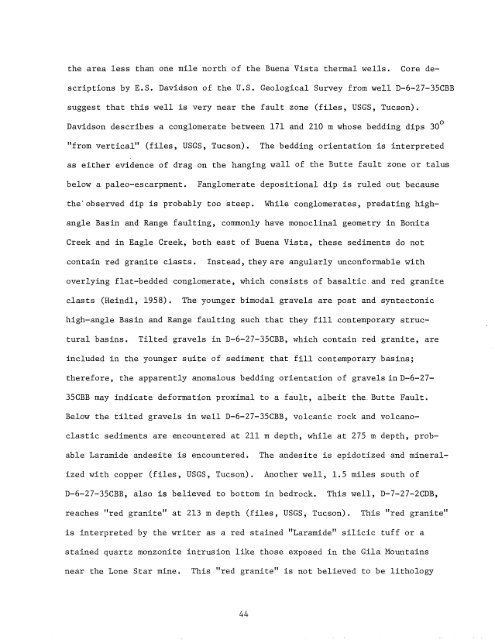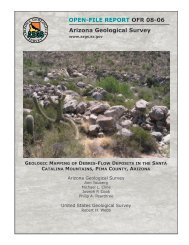geothermal resource potential of the safford-san simon basin, arizona
geothermal resource potential of the safford-san simon basin, arizona
geothermal resource potential of the safford-san simon basin, arizona
Create successful ePaper yourself
Turn your PDF publications into a flip-book with our unique Google optimized e-Paper software.
<strong>the</strong> area less than one mile north <strong>of</strong> <strong>the</strong> Buena Vista <strong>the</strong>rmal wells.<br />
Core descriptions<br />
by E.S. Davidson <strong>of</strong> <strong>the</strong> U.S. Geological Survey from well D-6-27-35CBB<br />
suggest that this well is very near <strong>the</strong> fault zone (files, USGS,<br />
Tucson).<br />
Davidson describes a conglomerate between 171 and 210 m whose bedding dips 30 0<br />
"from vertical" (files, USGS, Tucson).<br />
The bedding orientation is interpreted<br />
as ei<strong>the</strong>r evidence <strong>of</strong> drag on <strong>the</strong> hanging wall <strong>of</strong> <strong>the</strong> Butte fault zone or talus<br />
below a paleo-escarpment.<br />
Fanglomerate depositional dip is ruled out because<br />
<strong>the</strong>'observed dip is probably too steep.<br />
While conglomerates, predating highangle<br />
Basin and Range faulting, commonly have monoclinal geometry in Bonita<br />
Creek and in Eagle Creek, both east <strong>of</strong> Buena Vista, <strong>the</strong>se sediments do not<br />
contain red granite clasts.<br />
Instead, <strong>the</strong>y are angularly unconformable with<br />
overlying flat-bedded conglomerate, which consists <strong>of</strong> basaltic. and red granite<br />
clasts (Heindl, 1958).<br />
The younger bimodal gravels are post and syntectonic<br />
high-angle Basin and Range faulting such that <strong>the</strong>y fill contemporary structural<br />
<strong>basin</strong>s.<br />
Tilted gravels in D-6-27-35CBB, which contain red granite, are<br />
included in <strong>the</strong> younger suite <strong>of</strong> sediment that fill contemporary <strong>basin</strong>s;<br />
<strong>the</strong>refore, <strong>the</strong> apparently anomalous bedding orientation <strong>of</strong> gravels in D-6-27<br />
35CBB may indicate deformation proximal to a fault, albeit <strong>the</strong> Butte Fault.<br />
Below <strong>the</strong> tilted gravels in well D-6-27-35CBB, volcanic rock and volcanoclastic<br />
sediments are encountered at 211 m depth, while at 275 m depth, probable<br />
Laramide andesite is encountered.<br />
The andesite is epidotized and mineralized<br />
with copper (files, USGS, Tucson). Ano<strong>the</strong>r well, 1.5 miles south <strong>of</strong><br />
D-6-27-35CBB, also is believed to bottom in bedrock. This well, D-7-27-2CDB,<br />
reaches "red granite" at 213 m depth (files, USGS, Tucson). This "red granite"<br />
is interpreted by <strong>the</strong> writer as a red stained "Laramide" silicic tuff or a<br />
stained quartz monzonite intrusion like those exposed in <strong>the</strong> Gila Mountains<br />
near <strong>the</strong> Lone Star mine.<br />
This "red granite" is not believed to be lithology<br />
44

















